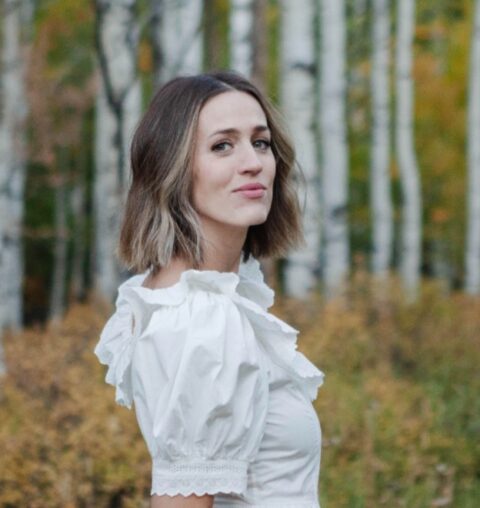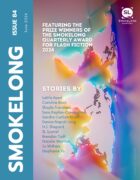First, congratulations on winning First Prize in SmokeLong Quarterly’s Award for Flash Fiction! I’d love to know where the inspiration for this story came from. What was the first element you had in your mind as you started writing?
Thank you so much for such kind words! I think and write a lot about fertility, childbirth, and motherhood because there really is so much to say about them. I’m always looking to find new and interesting angles to approach this topic, and the messier the better. Motherhood in particular is so glamorized when in actuality it’s messy in the best way. I want to deglamorize it. I want to write about mothers who aren’t angels or saints, but imperfect humans struggling to do their best, which makes them even better. Perfection is boring. In many ways, it feels like a feminist act to write about motherhood this way. As for the store, about five minutes away from my house there’s a big building that’s had several lives: a grocery store, a hardware store, furniture. It seems like a place where businesses go to die. I got to thinking about the building and the futile attempts to fill the space, and I started wondering if this thought could make any sense within the context of motherhood, or even lost motherhood.
The first sentence is so good. It grabbed my attention, but it does more than that. It introduces many important elements to the story: Nana, money, tigers, birth. Was this always the first sentence? How do you approach story beginnings?
I’ve been experimenting with stream of consciousness and less structured, punctuation-heavy writing. It has been so fun because it means I can really pack in a long, bristling, teeming wallop of a first sentence. I tend to write in a pretty linear way, so the first sentence, or something very close to it, was always up there at the top. Funnily enough, when I initially wrote this story, the mention of tigers was only going to be in that first sentence! It was only upon further revision that I included tigers in a bigger way, and I’m so glad I did because I think they add such compelling texture.
You let readers do some work to piece things together in this story (that the narrator lost her daughter Lily, probably in infancy, and I suspect this led to the end of her marriage). How did you decide how much to reveal and how much to hold back?
Determining how much to reveal and how much to hold back was incredibly fun to play around with. Sometimes I feel the need to give the reader as much help as possible because I so desperately want them to understand everything I’m trying to communicate in my writing, but then I feel frustrated when I’m reading or watching something, and the creator doesn’t seem to trust the audience! I’m bothered when too fine a point is put on things, and I really didn’t want that to happen here. I wanted to fill the story with wonder and unease. I love creating atmosphere in a story, using description to point at something without directly saying its name. I felt that with enough surrounding detail of the store, the rats, the dying food, and the rest, I could get away with only a few lines of specificity, and hope that my descriptions fill in the gaps.
One of my favorite moments is when the old friend enters the store. I love the hyperbole of the narrator thinking the friend has a hundred kids, and especially this: “I couldn’t think of anything to say about them so I said we have a sale on condiments today.” There’s something so devastating and honest about this. You use reported speech here (and throughout the story) which is very effective. I wonder how you came to this decision. How do you approach dialogue/speech in general in your work?
I love dialogue so much, to the point where I’ve had professors and workshoppers tell me I need to cut back on dialogue! I myself love to gab, and I enjoy discovering more about characters by having them talk to each other and seeing what comes out of their mouths. In this story, though, I wanted to try dialogue in a different way. I used reported speech because I wanted the words to feel intimate, like this hurting, yearning character had sat you down and tried to tell you everything that was in her heart, everything that had happened to her.
The end is exquisite. The way the narrator holds the bruised fruit, pressing their soft brown spots, begging them to stay alive just a little bit longer, it’s utterly heartbreaking and really ties the entire story together. It’s one of the best story endings I’ve ever read. How did you come to this as the end? Do you have any advice or strategies for nailing the end of a story?
I was very enamored with the idea of this character trying to carve out the best life for herself while feeling such pain. The image of her trying to succeed while being surrounded by dying food was both enchanting and haunting to me. She yearns to hold her own child in her arms, but since she’s not able to do so, produce is the next best thing. Plus fruit and vegetables are so human-body coded, with your ears of corn, your navel oranges, your flesh of fruit, and so on. It was like the produce had become her babies. Since her own baby couldn’t be the recipient of her focus anymore, this produce would be, bruised and dying even as it was. In terms of ending a story, I think it’s infinitely more important to evoke a feeling rather than tie a nice bow on the plot. Melancholy, unsettled, haunted, slightly hopeful, or yearning for more: These are the feelings that can make that last line soar.



 The SmokeLong Grand Micro Contest (The Mikey) is now an annual competition celebrating and compensating the best micro fiction and nonfiction online.
The SmokeLong Grand Micro Contest (The Mikey) is now an annual competition celebrating and compensating the best micro fiction and nonfiction online.